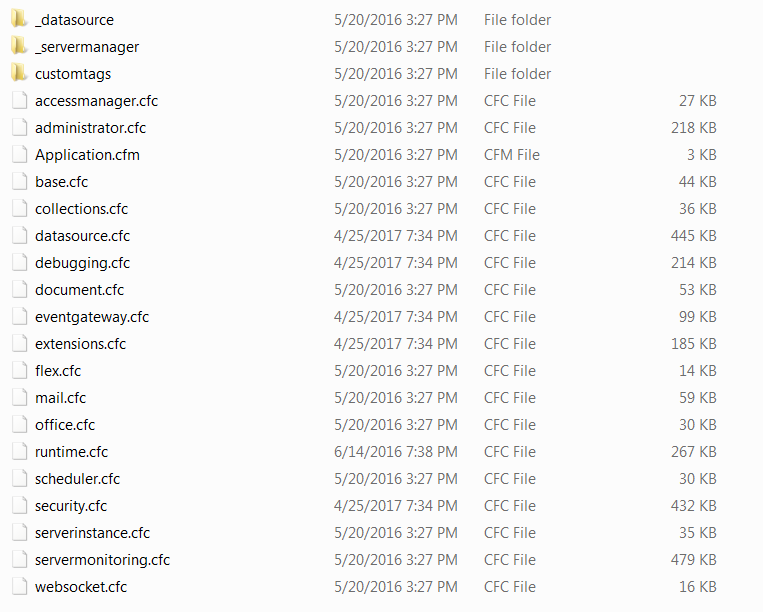For the past 4 years or so, I’ve been more active with the devops side of things. So, I was lucky enough to not work so closely to the business side anymore. That perk, though, came with a caveat. I was made responsible to provide optimizations and performance gains at the company’s main service, which unfortunately is largely built using one language thats hanging literally by a thread.
Yes, that language’s name is "Coldfusion". No, you have surely not heard of it before, and yes, luckily, it has nothing to do with physical cold fusion.
What is this Coldfusion?

Coldfusion, is a closed source language that was created by Adobe. It’s a language that was conceived in 1995 (!) and it’s purpose was to help people break the compiling loop that reigned the internet world back then.
Their first intent was to create a framework that would connect html pages with database engines, and thus providing an Api that would be very easy to change while coding websites.
Luckily, the first implementation of Coldfusion was coded in Visual C++ (god help us), and its runtime was strictly Windows, as back then the popular runtime and tools were being provided by the Gates family. There were some ports to Sun’s Solaris, but they were limited.
After version 6 with the debut of Coldfusion 6MX, everything moved to Java, where they stayed up to now. You can see my repo, thats a port of the popular SOLID pattern. Since I was hired as a Software engineer, I had to deal with code quality. The syntax is quite similar to javascript, but you can easily load java jars and run them directly (which actually gives the language actual leeway).
Ok, but, so whats this API you talking about?
If for some weird reason you have ended up in my position and Coldfusion is “paying your bills” you might end up reading up articles about how to do stuff.
Most helpful is Ben Nadel’s blog, this guy has been with Coldfusion since its first steps and he’s helped a lot lot of people with his posts. Ben will solve a lot of questions you will have when writing code with Coldfusion. He’s done a lot of good work, and also getting a lot of props for publishing his problems and solutions. There are also more resources you can address your questions at, I’ll just mention some here: official Coldfusion Adobe community community.adobe.com, the Adobe CF portal at coldfusion.adobe.com, CFML Slack, and more.
But there were times that we had to ask for professional help. Unfortunately Coldfusion is a closed source project. There is a respective open source implementation (called Lucee), but unfortunately – and that was explored when I was firstly joined – , it wasn’t 100% compatible with the company’s projects. Therefore, we were stuck with the closed source one, and even though its official documentation is good, Adobe, who’s got the reins in managing the whole language, at times, doesn’t really care what’s going on with the community. So, they are only answering the community’s questions only if they are under pressure.
The guy who’s applying pressure is Charlie Arehart. He’s liaised numerous times between popular questions (especially at the administration side of CF), and he’s doing a really good job.
Managing CF service
My troubles started when I was called to manage a Coldfusion service programmatically. CF, comes in a service – server package, which runs and you have the option of “visiting” a specially crafted server URL where you can point and click administrative options, after being authenticated. Options like for example change the code mappings, as to where the Coldfusion code resides inside your server, or, say, refresh something Coldfusion calls “query cache”.
Long story short, I had to find a way to make all those changes programmatically, as in any serious enterprise, you just can’t deal with point and click changes, iterating every single server.
Coldfusion Admin API
So luckily Coldfusion is exposing those Administrative functions in a form of an api. Charlies Admin API Blog Post, is descriptive enough to guide you through the process. So if for example you want programatically create some database connections (in CF world they are called “Data Source Objects”) you can do so like this:
<cfscript>
// Login is always required. This example uses two lines of
code.adminObj = createObject("component","cfide.adminapi.administrator");
adminObj.login("admin");
// Instantiate the data source
object.myObj = createObject("component","cfide.adminapi.datasource");
// Create a DSN.
myObj.setMSSQL(
driver="MSSQLServer",
name="northwind_MSSQL",
host = "xx.x.xxx.xx",
port = "1433",
database = "northwind",
username = "sa",
login_timeout = "29",
timeout = "23",
interval = 6,
buffer = "64000",
blob_buffer = "64000",
setStringParameterAsUnicode = "false",
description = "Northwind SQL Server",
pooling = true,
maxpooledstatements = 999,
enableMaxConnections = "true",
maxConnections = "299",
disable_clob = true,
disable_blob = true,
disable = false,
storedProc = true,
alter = false,
grant = true,
select = true,
update = true,
create = true,
delete = true,
drop = false,
revoke = false);
</cfscript>The API cfc files that are offered are the following:

Charlie in his blog says that he has asked the Adobe team to document the functions that each cfc exposes, but unfortunately Adobe, being Adobe, didn’t. They have merely documented 7 out of the 18 files, and the rest are left as they were.
If you wish to introspect the other files you can do so just by log into http://localhost:8500/CFIDE/administrator/index.cfm while running a CF Server installation, and then, head to Security -> RDS.

There you either disable RDS (not recommended for long run setups), or change the password.
After that you can simply follow the virtual path, ie, if you wish to introspect the runtime.cfc you can simply go to : http://localhost:8500/CFIDE/adminapi/runtime.cfc, and you will be met with the following page:
Or if you prefer a link, here
Just as you’ve guessed, this is all the CF API
So I went the extra mile and went and copied all the CF 2018 introspection code that Adobe is producing when visiting all the administrative modules listed in their server, by creating a complete “Coldfusion 2018 Admin API Documentation”.
You can just click the links below and you will get the html as it is being generated from the original Coldfusion Administration URL.
Event Gateway (care when you use this one, its severely outdated)
I hope this simplifies the administration
My attempt was purely drafted to help people so that they wouldn’t have to search locally or in a server to have the tools to administer their installation.
Since Adobe stopped the process of documenting, I felt this must have been done somewhere, so I took the initiative of putting it here.
Stay tuned, I will come back with some more posts about crypto — my new hobby!
EDIT: I will create another post documenting the CF2021 ones, as we will be soon migrating there as well.

